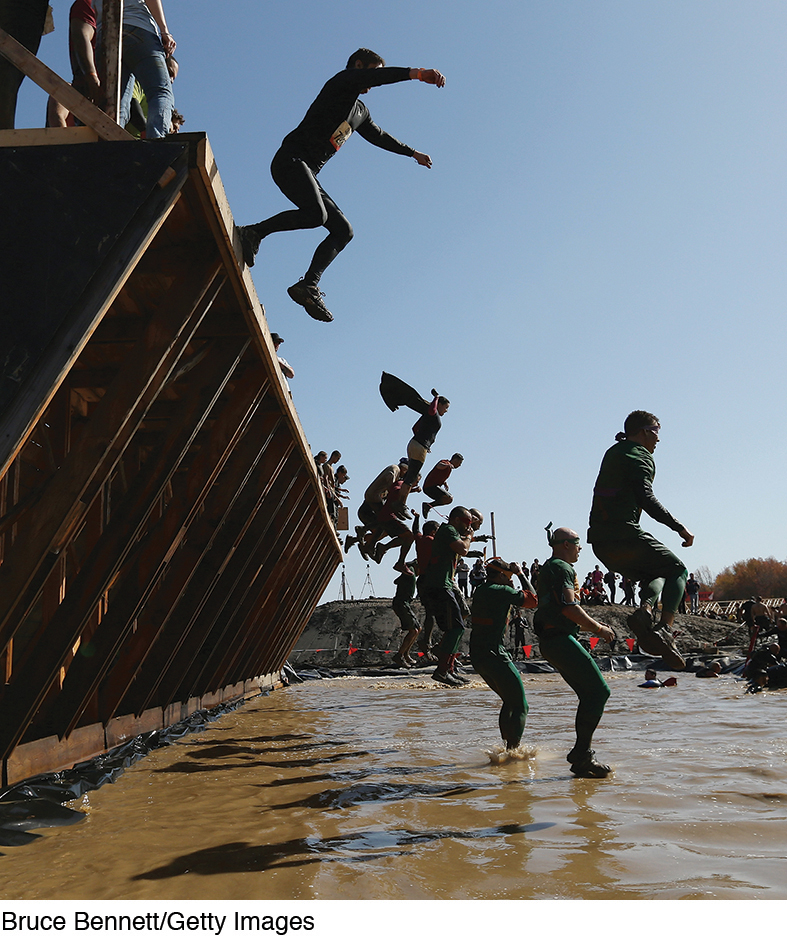Exploring Economics
1

Learning Objectives
1.1 Explain how economic analysis can be used in decision making.
1.2 Differentiate between microeconomics and macroeconomics.
1.3 Describe how economists use models.
1.4 Describe the ceteris paribus assumption.
1.5 Discuss the difference between efficiency and equity.
1.6 Describe the key principles in economics.
1.7 Apply the key principles to situations faced in everyday life.
Imagine jumping over open pits of fire, being chased by crazed people with sticks, diving through muddy pools of water under barbed wire, and climbing over a series of rocky walls. This does not describe a war zone or a military boot camp. Instead, these are typical challenges found in the increasingly popular sport of obstacle course racing. Also known as Warrior Dash, Tough Mudder, and Spartan Runs, obstacle course racing incorporates demanding physical and mental obstacles to challenge individuals over the standard 3-
Does this sound thrilling? Or perhaps crazy? These are common thoughts that come to mind when people talk about the increasing popularity of new adventure sports. Would you imagine that whether or not to participate in such an activity is an economic question? Most people probably would not. But this example resembles an economic problem in many ways. Obstacle course racing involves a challenge, one with a benefit (a sense of accomplishment) and a cost (including monetary costs, physical demands on the body, and a risk of injury). It involves tradeoffs such as the countless hours spent practicing and training in order to be successful. And it involves societal beliefs about whether such activities should be regulated or restricted to persons of a minimum age and well-
By the end of this course, you will come to understand that economics involves all types of decisions, from small everyday decisions on how to manage one’s time to world-
You still might be asking yourself: Why should I study economics? First, you will spend roughly the next 40 years working in an economic environment: paying taxes, experiencing ups and downs in the overall economy, investing money, and voting on various economic issues. It will benefit you to know how the economy works. More important, economic analysis gives you a structure from which you can make decisions in a more rational manner. Economics teaches you how to make better and wiser decisions given your limited resources. This course may well change the way you look at the world. It can open your eyes to how you make everyday decisions, from what to buy to where you choose to live.
Like our opening example, economic analysis involves decisions that are not just “economic” in the general sense of the term. Certainly, economic thinking may change your views on spending and saving, on how you feel about government debt, and on your opinion of environmental policies or globalization. But you also may develop a different perspective on how much time to study for each of your courses this term, or where you might go for spring break this year. Such is the wide scope of economic analysis.
This introductory chapter takes a broad look at economics. First, we study a key method of economic analysis: model building. Economists use stylized facts and the technique of holding some variables constant to develop testable theories about how consumers, businesses, and governments make decisions. Then we turn to a short discussion of some key principles of economics to give you a sense of the guiding concepts you will encounter across in this book.
This chapter will give you a sense of what economics is, what concepts it uses, and what it finds to be important. Do not go into this chapter thinking you have to memorize these concepts. Rather, use this chapter to get a sense of the broad scope of economics. You will be given many opportunities to understand and use these concepts throughout this course. Return to this chapter at the end of the course and see if everything has now become crystal clear.